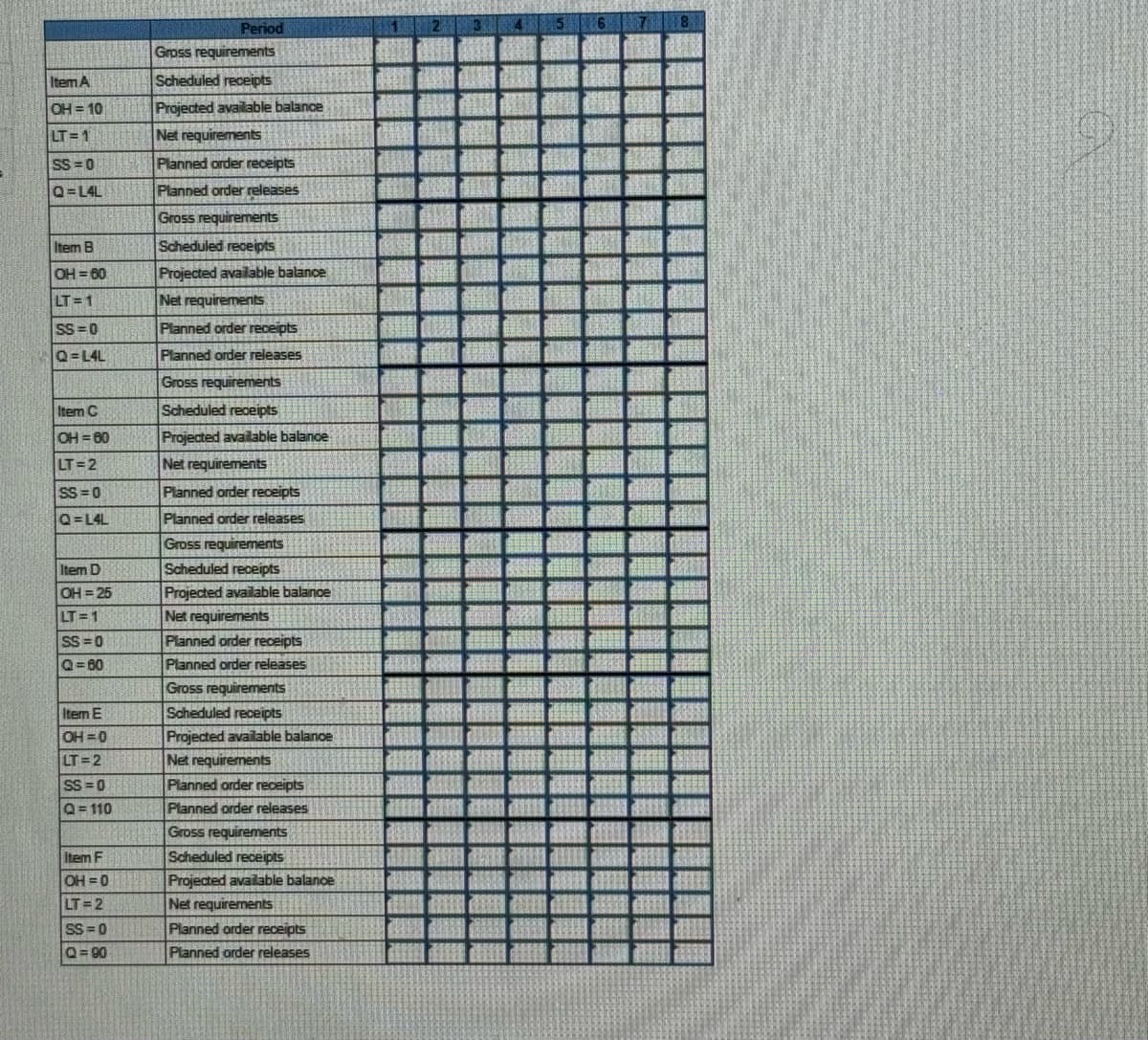One unit of A is composed of two units of B and three units of C. Each B is composed of one unit of F. C is made of one unit of D, one unit of E, and two units of F. Items A, B, C, and D have 10, 60, 60, and 25 units of on-hand inventory. Items A, B, and C use lot-for-lot (L4L) as their lot-sizing technique, while D, E, and F require multiples of 60, 110, and 90, respectively, to be purchased. B has scheduled receipts of 30 units in Period 1. No other scheduled receipts exist. Lead times are one period for Items A, B, and D, and two periods for Items C, E, and F. Gross requirements for A are 10 units in Period 1, 20 units in Period 2, 60 units in Period 6, and 40 units in Period 8. Period OH=10 LT=1 Item A Gross requirements Scheduled receipts Projected available balance Net requirements SS=0 Planned order receipts Q=L4L Planned order releases Gross requirements Item B Scheduled receipts OH=60 Projected available balance LT=1 Net requirements SS=0 Planned order receipts Q=L4L Planned order releases Gross requirements Item C Scheduled receipts OH=60 Projected available balance LT=2 Net requirements SS=0 Planned order receipts Q=L4L Planned order releases Gross requirements Item D OH=25 LT=1 SS=0 Q=60 Item E OH=0 LT=2 Net requirements SS=0 Q=110 Gross requirements Item F OH=0 Scheduled receipts Projected available balance LT=2 Net requirements SS=0 Planned order receipts Q=90 Planned order releases Scheduled receipts Projected available balance Net requirements Planned order receipts Planned order releases Gross requirements Scheduled receipts Projected available balance Planned order receipts Planned order releases 8
One unit of A is composed of two units of B and three units of C. Each B is composed of one unit of F. C is made of one unit of D, one unit of E, and two units of F. Items A, B, C, and D have 10, 60, 60, and 25 units of on-hand inventory. Items A, B, and C use lot-for-lot (L4L) as their lot-sizing technique, while D, E, and F require multiples of 60, 110, and 90, respectively, to be purchased. B has scheduled receipts of 30 units in Period 1. No other scheduled receipts exist. Lead times are one period for Items A, B, and D, and two periods for Items C, E, and F. Gross requirements for A are 10 units in Period 1, 20 units in Period 2, 60 units in Period 6, and 40 units in Period 8. Period OH=10 LT=1 Item A Gross requirements Scheduled receipts Projected available balance Net requirements SS=0 Planned order receipts Q=L4L Planned order releases Gross requirements Item B Scheduled receipts OH=60 Projected available balance LT=1 Net requirements SS=0 Planned order receipts Q=L4L Planned order releases Gross requirements Item C Scheduled receipts OH=60 Projected available balance LT=2 Net requirements SS=0 Planned order receipts Q=L4L Planned order releases Gross requirements Item D OH=25 LT=1 SS=0 Q=60 Item E OH=0 LT=2 Net requirements SS=0 Q=110 Gross requirements Item F OH=0 Scheduled receipts Projected available balance LT=2 Net requirements SS=0 Planned order receipts Q=90 Planned order releases Scheduled receipts Projected available balance Net requirements Planned order receipts Planned order releases Gross requirements Scheduled receipts Projected available balance Planned order receipts Planned order releases 8
Practical Management Science
6th Edition
ISBN:9781337406659
Author:WINSTON, Wayne L.
Publisher:WINSTON, Wayne L.
Chapter4: Linear Programming Models
Section: Chapter Questions
Problem 111P
Related questions
Question
Find the planned order for all items.

Transcribed Image Text:One unit of A is composed of two units of B and three units of C. Each B is composed of one unit of F. C is made of one unit of D, one
unit of E, and two units of F. Items A, B, C, and D have 10, 60, 60, and 25 units of on-hand inventory. Items A, B, and C use lot-for-lot
(L4L) as their lot-sizing technique, while D, E, and F require multiples of 60, 110, and 90, respectively, to be purchased. B has scheduled
receipts of 30 units in Period 1. No other scheduled receipts exist. Lead times are one period for Items A, B, and D, and two periods for
Items C, E, and F. Gross requirements for A are 10 units in Period 1, 20 units in Period 2, 60 units in Period 6, and 40 units in Period 8.

Transcribed Image Text:Period
OH=10
LT=1
Item A
Gross requirements
Scheduled receipts
Projected available balance
Net requirements
SS=0
Planned order receipts
Q=L4L
Planned order releases
Gross requirements
Item B
Scheduled receipts
OH=60
Projected available balance
LT=1
Net requirements
SS=0
Planned order receipts
Q=L4L
Planned order releases
Gross requirements
Item C
Scheduled receipts
OH=60
Projected available balance
LT=2
Net requirements
SS=0
Planned order receipts
Q=L4L
Planned order releases
Gross requirements
Item D
OH=25
LT=1
SS=0
Q=60
Item E
OH=0
LT=2
Net requirements
SS=0
Q=110
Gross requirements
Item F
OH=0
Scheduled receipts
Projected available balance
LT=2
Net requirements
SS=0
Planned order receipts
Q=90
Planned order releases
Scheduled receipts
Projected available balance
Net requirements
Planned order receipts
Planned order releases
Gross requirements
Scheduled receipts
Projected available balance
Planned order receipts
Planned order releases
8
Expert Solution
This question has been solved!
Explore an expertly crafted, step-by-step solution for a thorough understanding of key concepts.
This is a popular solution!
Trending now
This is a popular solution!
Step by step
Solved in 2 steps

Recommended textbooks for you

Practical Management Science
Operations Management
ISBN:
9781337406659
Author:
WINSTON, Wayne L.
Publisher:
Cengage,

Practical Management Science
Operations Management
ISBN:
9781337406659
Author:
WINSTON, Wayne L.
Publisher:
Cengage,